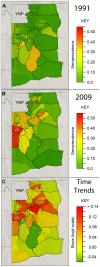Mapping brucellosis increases relative to elk density using hierarchical Bayesian models
- PMID: 20428240
- PMCID: PMC2859058
- DOI: 10.1371/journal.pone.0010322
Mapping brucellosis increases relative to elk density using hierarchical Bayesian models
Abstract
The relationship between host density and parasite transmission is central to the effectiveness of many disease management strategies. Few studies, however, have empirically estimated this relationship particularly in large mammals. We applied hierarchical Bayesian methods to a 19-year dataset of over 6400 brucellosis tests of adult female elk (Cervus elaphus) in northwestern Wyoming. Management captures that occurred from January to March were over two times more likely to be seropositive than hunted elk that were killed in September to December, while accounting for site and year effects. Areas with supplemental feeding grounds for elk had higher seroprevalence in 1991 than other regions, but by 2009 many areas distant from the feeding grounds were of comparable seroprevalence. The increases in brucellosis seroprevalence were correlated with elk densities at the elk management unit, or hunt area, scale (mean 2070 km(2); range = [95-10237]). The data, however, could not differentiate among linear and non-linear effects of host density. Therefore, control efforts that focus on reducing elk densities at a broad spatial scale were only weakly supported. Additional research on how a few, large groups within a region may be driving disease dynamics is needed for more targeted and effective management interventions. Brucellosis appears to be expanding its range into new regions and elk populations, which is likely to further complicate the United States brucellosis eradication program. This study is an example of how the dynamics of host populations can affect their ability to serve as disease reservoirs.
Conflict of interest statement
Figures





References
-
- Anderson RM, May RM. Oxford: Oxford University Press; 1991. Infectious Diseases of Humans: Dynamics and Control.757
-
- Hudson PJ, Rizzoli A, Grenfell BT, Heesterbeek H, Dobson AP. Oxford: Oxford University Press; 2001. The Ecology of Wildlife Diseases.197
-
- Kermack WO, McKendrick AG. Contributions to the mathematical theory of epidemics. Proceedings of the Royal Society of Edinburgh. 1927;115:700–721.
-
- Bartlett MS. Measles periodicity and community size. Journal of the Royal Statistical Society. 1957;120:48–71.
-
- Cauchemez S, Valleron A, Boëlle P, Flahault A, Ferguson NM. Estimating the impact of school closure on influenza transmission from sentinel data. Nature. 2008;452:750–754. - PubMed
Publication types
MeSH terms
LinkOut - more resources
Full Text Sources

